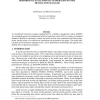Free Online Productivity Tools
i2Speak
i2Symbol
i2OCR
iTex2Img
iWeb2Print
iWeb2Shot
i2Type
iPdf2Split
iPdf2Merge
i2Bopomofo
i2Arabic
i2Style
i2Image
i2PDF
iLatex2Rtf
Sci2ools
VLDB
1987
ACM
1987
ACM
Performance Evaluation of an Operating System Transaction Manager
A conventional transaction manager implemented by a database management system (DBMS) was compared against one implemented within an operating system (OS) in a variety of simulated situations. Models of concurrency control and crash recovery were constructed for both environments, and the results of a collection of experiments are presented in this paper. The results indicate that an OS transaction manager incurs a severe performance disadvantage and appears to be feasible only in special circumstances.
Conventional Transaction Manager | Database | OS Transaction Manager | Transaction Manager | VLDB 1987 |
Related Content
| Added | 28 Aug 2010 |
| Updated | 28 Aug 2010 |
| Type | Conference |
| Year | 1987 |
| Where | VLDB |
| Authors | Akhil Kumar, Michael Stonebraker |
Comments (0)

